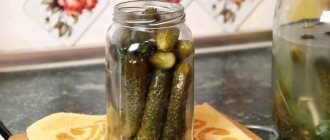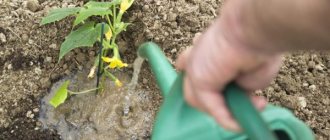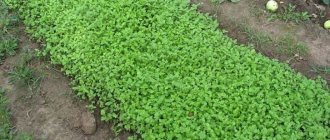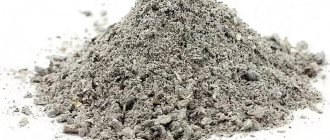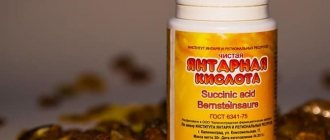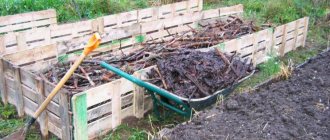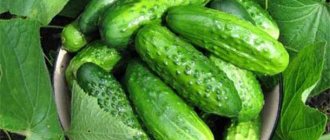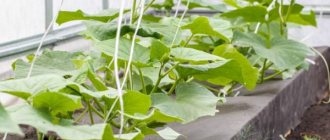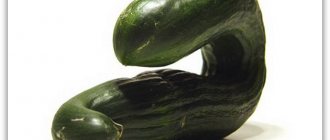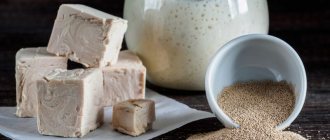Elements in bread that are beneficial for plants
Nowadays on the Internet you can find many publications about grain fertilizers for plants. When trying to justify their benefits, authors often mention yeast. And yeast, as any plant grower knows, belongs to the category of “effective microorganisms.” Find out in more detail → using yeast as a top dressing, how to prepare an infusion + reviews from gardeners.
The myth that yeast bread contains yeast is widespread not only among summer residents. In fact, these fungi are completely killed during baking. All that remains of them are memories in the form of a spongy structure inherent in bread crumb.
What and when to feed
The use of grain fertilizer requires compliance with a number of mandatory rules:
- use it only in the first half of summer, when the earth and air have warmed up enough, otherwise you won’t get any effect from it. This fertilizer works especially fruitfully in a greenhouse, where the temperature is always high;
- it acts as a bioactive growth simulator, so it is used to water young plants before fruiting begins;
- Before each feeding, preliminary irrigation is carried out, the roots absorb nutrients only in dissolved form;
- yeast infusions cannot replace complex fertilizers, they only act as growth catalysts;
- the soil is saturated with nitrogen, but loses calcium. It is recommended to combine grain feeding with the use of ash and eggshell powder;
- Do not fertilize sick plants;
- the resulting infusion is always very rich; before use, excess concentrate is diluted with water in a ratio of 1:10;
- after preparing the stimulating solution, it must be used within 12 hours, as it is not suitable for long-term storage;
- The infusion should be used in the garden and beds no more than 2-3 times per season. Only cucumbers do not fit into this rule; they can be watered with the stimulant up to 6 times.
Important! Some plants have their own preferences. For example, those who love acidic soils respond better to an infusion of rye bread. These are peonies, hydrangeas, primroses, azaleas. It’s a good idea to fertilize strawberries with this solution. White bread is suitable for feeding carrots.
Almost all the most popular vegetables are fed this way:
- cucumbers;
- nightshade crops (tomato, pepper, eggplant, physalis);
- strawberries;
- cabbage;
- pumpkin plants (zucchini, squash, crookneck);
- beans;
- sunflower;
- perennial flowers (roses, hydrangeas, peonies, azaleas, heathers, poppies);
- berry bushes;
- fruit trees.
Grain fertilizers are especially good for plants with thin root systems, as they act by stimulating the roots.
Some vegetables do not like such fertilizers:
- onion;
- garlic;
- potato.
In order for grain feeding to bring maximum benefit, it is used twice:
- a week after planting the seedlings in a permanent place, after watering with nitrogen-containing fertilizer;
- before flowering, after applying phosphorus-containing preparations.
The consumption rate of the tincture is 0.5 liters for a bush of seedlings, 1 liter - before blooming, 2 liters - during fruiting. At least 1 bucket is poured under a berry garden, and 50 liters or more under an adult tree.
An exception to this rule are cucumbers, which can be fed with grain fertilizer every 7-10 days until they begin to wilt in September.
It stimulates new waves of fruiting and has a positive effect on the taste of greens. Moreover, it is believed that bread fertilizer acts better on this vegetable than yeast fertilizer. To prepare a nutritious infusion, you need to take rye bread with malt, which accelerates the fermentation of the sourdough.
The fertilizer is diluted three times, a matchbox of combined mineral fertilizers or half a bottle (10 g) of iodine is dissolved in 12 liters.
This type of feeding works very well for seedlings - they stop stretching, quickly grow powerful roots and green mass, and survive picking and transplanting into the ground well. Rooting of cuttings of berry and ornamental shrubs is also progressing at a rapid pace.
Just like yeast tincture, bread fertilizer can protect some plants from common diseases. It saves tomatoes from late blight, and strawberries from gray rot. To do this, you need to apply foliar feeding to the leaf a couple of times, diluting the infusion twice as much as usual.
It has long been known in gardening that cucumbers, tomatoes and peonies are very fond of yeast and grain fertilizers. They simply rage from the use of such fertilizers. In addition to these plants, infusions from bread showed excellent results on currant plantations.
Feeding with starch not only increases yield, currant berries grow larger and sweeter. Potato peelings are often used for enhanced nutrition. But you can use grain fertilizer, which is used to water the bushes three times:
- for the first time when the ovaries are still green;
- in the second - when the berries are already ripe;
- in the third - a week before harvesting.
Liquid organic fertilizers are applied into the furrows along the projection of the foliage, moving away from the stems, and incorporated into the soil.
Important! An excess of bread infusions should not be allowed, but there will not be much harm from them. After all, in fact, they are biostimulants of soil fertility. These are not chemicals, but live mushrooms. All they know is to eat organic food correctly.
In the fall, a month before the onset of cold weather, the contents of a barrel of grain fertilizer are poured onto the beds and covered with film. Weak vapors of alcohol from flour infusion, warmth, and moisture stimulate the friendly germination of weeds, which will die from the onset of frost.
All this can be repeated in the spring, as soon as the snow melts on the site. Then weeds will not appear in the beds for a long time.
The effect of grain fertilizers on plants
Making fertilizer from bread is a decent way to utilize this product.
The effect of grain supplements quickly becomes noticeable due to the following signs:
- the area of the leaf plates increases;
- the color of the leaf blades becomes rich, bright green;
- the strength of the shoots increases and their thickness increases;
- plants almost do not react to temperature changes and become more drought-resistant;
- flowering energy increases, fruit set improves.
In 2003, a gardener with 30 years of experience, P.V. Antonov conducted an experiment on his cucumber plot. I planted half of the seedlings in bread mush and then fed them with bread several more times. The second half was grown on mineral fertilizers. The result was interesting:
“Initially, both groups developed equally. “Mineral” even outperformed a little, having started flowering 3 days earlier. But since mid-summer, when the rains began to pick up, the situation has changed dramatically. The “mineral” cucumbers began to slowly die and eventually developed powdery mildew. The “grain farmers”, sitting nearby, didn’t even “sneeze” - they continued to produce crops and looked strong and healthy.”
P.V. Antonov, experienced vegetable grower
These data allow us to consider bread as a fertilizer that not only stimulates the development and growth of plants, but also increases their immunity to seasonal infections.
Feeding tomatoes with bread
Bread feeding of tomatoes is carried out during flowering and during the ovary period no more than once every 20 days. Fertilizers are applied when the soil is well heated, otherwise there will be no benefit from it. Bacteria are highly active only in a warm environment.
For tomatoes, prepare an infusion of 3-4 rolls and 15 liters of water. This composition ferments for 2-3 days. Then the strained mash is diluted again with water (1:10). Seedlings are watered at the roots in the evening. With the correct use of fertilizers, tomatoes grow actively and have ovaries until late autumn.
Crops responsive to grain fertilizers
The general strengthening effect of grain fertilizers on plants makes them more resilient and helps them resist biotic and abiotic unfavorable factors.
According to the results of numerous observations, the following crops respond best to grain fertilizers:
- cucumbers;
- zucchini;
- squash;
- tomatoes;
- peppers;
- garden strawberries.
Carrots, beets, legumes, and garden flowers react moderately to watering with bread starters.
Feeding pepper bread
Bread infusion improves the soil structure and helps the plant cope with difficult weather conditions. Such fertilizers are applied to peppers planted in a greenhouse or open ground. The main thing is that the soil warms up well and the yeast starts working. The composition of the infusion for pepper is no different from cucumber or tomato. It is applied at the stage of appearance of the first true leaves once every 3-4 weeks, then during flowering and after harvesting the first harvest.
If the pepper sprouts have turned pale and the edges of the leaves have dried out, you should not feed it with bread infusion. These are the first signs of potassium deficiency.
Timing and methods of applying grain fertilizers to the soil
In order for the effect of grain fertilizer to be observed for a long time, fertilizing begins from the moment the plants are planted in the ground. They continue until the end of August.
There are several basic ways to feed plants with bread: place the fertilizer in the planting hole, water with universal starter, prepare EM fertilizer (find out → EM preparations: types, applications and reviews). Each of these methods is implemented as follows:
| Feeding method | Recipe | Application |
| Feeding in the hole | Half a bucket of leftover bread is filled with warm, settled water. After the bread has become soggy, it is ground into a liquid pulp by hand. | When planting plants, 1 cup of bread gruel is added to the bottom of the hole, after which the seedlings are planted. |
| Universal starter | A third of the bucket of leftover bread is pressed down under pressure, and the bucket is filled with warm water almost to the top. Cover with a lid and leave for 3 days. On the 4th day, 1 glass of sugar is poured into the bucket, the pressure is removed, the mass is mixed and left for another 3 days. | The starter is used without filtration. The required amount is collected in a jar and poured under the root of the plants. The consumption rate for young plants is 250 ml. The consumption rate for adult bushes is 0.5 liters. |
| Grain EM fertilizer | A quarter of the bucket is filled with leftover bread. Another quarter - chopped green mass of nettles. Add 1 cup of sugar and half a packet of dry yeast. Everything is poured with warm water, mixed and left to ferment for a week. | The fertilizer is filtered and diluted with water in a ratio of 1:5. Plants are watered at the root or between rows. The consumption rate is 1 liter per bush or 5 liters per 1 m2. |
Bread can also be used for foliar feeding. To prepare them, the whole loaf is soaked overnight in a bucket of water. Then the bread is slightly kneaded and left for another 2 hours. After this time, the liquid is carefully filtered. 10 ml of iodine is added to the resulting nutrient solution. Plants are sprayed leaf by leaf.
Tip #1 . Practice shows that fertilizers prepared from black rye bread are more effective than those prepared from white. This is explained by the higher content of B vitamins in rye flour.
Bread infusion for cucumbers with iodine
There is probably not a single gardener who does not grow cucumbers on his plot. That is why the topic of feeding is important and always relevant. When feeding cucumbers with manure, very often the root system of the plants begins to hurt. As a result, various inclusions appear on the leaves, and the leaf blades along the edges begin to turn yellow. And the application of mineral fertilizers, especially during the fruiting period, leads to the accumulation of nitrates in the fruits.
Therefore, it is best to use natural organic fertilizers; even an excess of them cannot harm either the plant or the person. And one of the safest ways is to use bread infusion, or rather the yeast that is always in it.
The infusion is prepared according to the same principle, no matter what you want to use it for.
- 1 loaf or loaf of black bread is cut into slices or small pieces and soaked in 10 liters of warm water,
- The top of the container is closed tightly with a lid,
- Leave to brew for several days
- The infusion is filtered and it is ready for use.
Fertilizing of cucumbers is carried out every 2-3 weeks, they are especially necessary during the period of fruit set and fruiting. For greater efficiency, iodine is added to the infusion. Of course, they can do without it. Iodine is a very useful microelement that plants need. In addition to the fact that it has a beneficial effect on the growth and development of the plant, it also prevents the occurrence of various diseases on cucumbers. Also, when preparing fertilizer, ash is added.
Half a bottle (10 ml) of alcohol tincture of iodine is poured into the prepared infusion. Having added iodine, mix the infusion well, and then carry out foliar feeding, irrigating the leaves with the infusion from a sprinkler. For root feeding, 0.5-1 liters of solution is watered under each plant.
Thanks to grain fertilizer, cucumbers
- become more resilient to sudden weather changes.,
- less susceptible to diseases,
- their root system is strengthened and shoots become stronger,
- the growth of vegetative mass and the appearance of ovaries is accelerated,
- The taste and aroma of the fruits themselves improves significantly.
The use of grain fertilizers when growing cucumbers
To speed up the transfer of nutrients into solution, it is advisable to pre-grind the bread.
Cucumbers and other pumpkin crops respond most intensely to grain fertilizers. When growing them, all feeding methods are used:
- when planting seedlings - bread gruel;
- after setting the first fruits, water with universal starter;
- with the beginning of mass fruiting - watering with EM fertilizer once every two weeks;
- from the end of July - spraying with bread-iodine agent.
The best way to grow seedlings is bread infusion
At the initial stage of plant development, when tomatoes, peppers, eggplants, and cucumbers are grown as seedlings, feeding them with bread infusion will be extremely useful. The seedlings will quickly respond to the fertilizer, since its root system will very quickly strengthen, which means the plant will receive all the substances it needs for growth.
Later, when the seedlings are transplanted to a permanent place, they will adapt faster and better to new conditions. In addition, it will be easier to resist various pathogens.
The solution is prepared as usual. First, the bread is infused for a week in water. Seedlings do not need a strong concentration, so the resulting solution is diluted in a ratio of 1:10. And with this solution the seedlings are watered 1-2 times a week. In a few days you will notice how your seedlings have grown stronger.
Grain supplements for tomatoes and peppers
It is very important to accompany such fertilizing by mulching the soil in the cucumber or squash bed.
This is necessary for long-term preservation of normal soil moisture, which promotes good absorption of nutrients by the roots. Tomato and pepper seedlings react incorrectly to bread mush in the holes. When planting these plants in the ground, it is better not to add this fertilizer at the root, otherwise they will begin to “fatten” - driving away powerful foliage and many stepsons.
You can start feeding tomatoes with bread after the first cluster has flowered. It is given to peppers after the first ovaries appear. For tomatoes that like a slightly acidic soil reaction, a universal starter is more suitable. It is better to offer peppers EM fertilizer with yeast and nettle.
If the soil has a strongly acidic reaction ( pH 5.0 and below), it is better to prepare the bread starter with wood ash. A large number of calcium compounds in this material neutralizes increased acidity, and nutrients are better absorbed by plant roots.
To reduce the effect of the acidity of the bread sourdough on the soil, simultaneously with watering, you can add crushed eggshells to the soil. Find out → how to mulch beds with sawdust, straw, grass, leaves, → using eggshells as top dressing.
Grain fertilizer as a fertilizer for plants - pros and cons
Fertilizing from bread is a very necessary and useful fertilizer, especially during the fruiting period. As already mentioned, the main useful component is yeast. These are single-celled fungi from the Saccharomyces family, which contain a huge amount of macro- and microelements, so they are used not only in cooking and cosmetology, but are widely used in gardening. They have a whole range of useful properties:
- Increases plant immunity to adverse weather conditions;
- Increase resistance to various infections;
- Accelerate the formation of the root system and strengthen it;
- Increase the vegetative mass of the plant;
- They are growth stimulants;
- The taste of vegetables improves and yield increases.
The action of yeast in the soil is the formation and reproduction of soil bacteria. Bacteria, in the process of their vital activity, process organic substances, resulting in the formation of nitrogen and potassium, important elements for the growth of any plant.
However, there is a drawback when using bread infusion as a fertilizer. Yeast reduces the calcium content in the soil. Therefore, in parallel with this feeding, it is necessary to add fertilizers containing calcium, for example, eggshells or wood ash. In addition, the fertilizer acidifies the soil, so it is more rational to use it on alkaline or neutral soil. And adding manure or chicken droppings to the infusion neutralizes the effect of yeast, so they should not be added when preparing the solution.
Bread infusion helps fight weeds. Having fertilized the bed in early spring, the remaining seeds germinate quickly. When forming the beds, the emerging weeds are removed and in the near future they will not appear again for a long time. You can fight weeds in the fall in a similar way.
Remember! When buying bread to feed plants, make sure it contains yeast. Bread with dyes or without yeast is not suitable for feeding.
Bread fertilizers for garden strawberries
Many fruit growers note the positive effect of bread on the development and fruiting of garden strawberries. This crop urgently needs the assistance of beneficial soil microflora, which fixes nitrogen and converts other mineral salts into digestible form.
Adding bread gruel to the holes when planting young strawberry bushes helps to activate soil microorganisms. However, strawberries do not require a lot of bread. Feeding is done according to the following scheme:
- During planting, 2 tablespoons of gruel are placed in the hole and this type of fertilizer is no longer used in the first year.
- In subsequent years, two fertilizings with universal starter are performed per season. One - in the spring, before flowering. The second is in early August.
If strawberries are not remontant and produce only one harvest per year, you can only get by with spring feeding.
Feeding with bread infusion, white bread recipe
White bread mash is less concentrated. It is prepared similarly to fertilizers based on black bread. An infusion of white pieces is most often used to feed carrots. You can add weeds and manure to its composition. During the season, 2-4 waterings are carried out. Excessive yeast feeding leads to increased soil acidity. In such cases, liming is required.
Reviews on the effectiveness of grain supplements
Crops that do not respond well to root feeding with bread can be fertilized leaf by leaf with green EM fertilizer.
On the forums of summer residents you can find a lot of stories about the use of bread and conclusions about the effectiveness of this type of fertilizer. Most of them are positive:
“Cucumbers have never worked out for me. It seemed like they were growing normally, but the harvests were as big as hell, barely enough for a salad. On the advice of forum members, I tried to feed my cucumbers with bread. It’s August now, I’ve already picked up a bucket of greens. Flowering continues, there are many ovaries. I’m very pleased with the result and grateful for the useful advice!” (Svetlana, Izhevsk).
“My climbing roses really liked watering them with bread kvass! The leaves are glossy, bright, and there are never any spots. Only recently I began to dilute the starter with water more strongly - about 1:10. I noticed that not only roses, but also ants like a stronger solution” (Olga, Kaliningrad).
Feeding with bread infusion, recipe from black bread
For yeast infusion, it is advisable to use black bread. Its yeast is more active. The loaf of bread is cut into pieces and slightly dried. You can make a grain supply during the winter from waste pulp and crusts. Half a bucket of black crackers is poured with warm water (5 liters) and left in the sun to ferment. The top is covered with a lid. After a week, the mash is decanted and diluted with water (1:2 or 1:3). Plants that love acid are most often fertilized at the root.
The prepared infusion is used immediately, otherwise it will lose its healing properties.
Current issues in grain feeding
Question No. 1. Is it possible to use moldy bread for feeding?
It is forbidden. Mold on bread most often appears as a result of the proliferation of fungi of the genus Penicillum. Despite the fact that the world's first antibiotic was isolated from them, which saved the lives of millions of people, these fungi can be dangerous to plants. They cause penicillosis on the fruits of tomatoes, grapes and strawberries. Penicillums are especially harmful to bulbous crops. That is why they are not fed even with clean, not moldy bread.
Question No. 2. Is it possible to use grain fertilizers to fertilize indoor plants?
Can. A universal bread starter is suitable for this. For indoor flowers it is prepared in the same way as for vegetable crops, only in a small volume - for example, in a saucepan. The only significant difference is that in this case, the starter should be filtered before watering.
Sometimes you can come across this advice: put bread crumbs in pots when replanting plants.
However, it must be used with caution. Such an additive in pots can provoke the appearance of midges, mold or enchytraeus worms. Rate the quality of the article. We want to be better for you:
Feeding peonies with bread
For normal growth, budding and flowering, peonies require at least three seasonal feedings. At the first stage, immediately after the snow melts, chemical fertilizers are applied, at the second stage, during the budding period in early summer, bread infusions can be used. They are prepared on the basis of rye bread, warm water and with the addition of sugar. The loaf is cut into slices, filled with a bucket of warm water and 250 g of sugar are added. Cover the bucket and leave it warm for 3 hours. The resulting mash is used for root feeding. The cake can also be dug under the roots. After such watering, peonies will definitely delight you with vigorous and long-lasting flowering.
Bread infusion is the simplest and cheapest type of natural fertilizer that is suitable for most plants.
Tips for using bread solutions
Experienced gardeners have their own secrets, which they are happy to share:
- The composition of a starter made only from water and bread is not sufficiently balanced, so the mixture should be enriched with finely chopped dandelion or nettle greens, adding means to enrich the soil with minerals, as well as wood ash, manure or bird droppings diluted with water;
- If the soil on your site is fertile, then you should not overuse fertilizers and apply grain fertilizer more than three times a season. It can be applied to depleted soil up to 10 times with intervals of 10-14 days;
- The bread grounds remaining after decanting the infusion can significantly improve the quality of the compost, so add it to the compost pit;
- You should not water weakened, diseased or damaged bushes with bread leaven;
- In extreme heat, yeast loses its life-giving power. Therefore, on hot days, apply fertilizer after sunset to heavily moistened soil;
- Be sure to strain the tincture through a sieve or cheesecloth. Because the bread crumbs remaining in it form a waterproof film on the ground, and also attract rodents that can destroy the crop. Be sure to thoroughly loosen the soil 1-2 days after adding the starter.
The prepared bread solution should not be stored for more than 10 days, after which it loses its value and can do more harm than good. The solution cannot be heated to more than 40 degrees, otherwise the beneficial substances will lose their properties. The main advantage of this fertilizer is its organic origin, ease of production and availability. To prepare it, you can use any kind of bread and crackers, even spoiled ones with mold.
Bread as fertilizer for the garden: recipes for feeding
Every vegetable grower dreams of increasing the productivity of his plants in the beds by any means possible, finding new recipes for fertilizing green spaces or using old, time-tested methods. In the garden, everything that is on the farm is used. Among others, fertilizers from any bread are used
for plants as a cheap and effective fertilizer.
How to make and apply fertilizer from bread
To prepare the fertilizer, both fresh and dried or dried bread is used. White, black or rye bread will do. If mold appears on the old pieces, they can also be used. This type of mold does not take root on plants and will not harm them.
Place the pieces of bread in a large saucepan or bowl and cover with water. Press down the bread crusts on top so that they do not float, and put the workpiece in a warm place for a week. Strain the prepared solution through cheesecloth and dilute a little with water. Water young plants that are in the active growth phase at the root.
Grain fertilizer is used with caution and in limited quantities for diseased plants. It is also not recommended to frequently feed mature, already formed bushes. This can cause growth to stop.
To compensate for the lack of calcium, which is absorbed during the fermentation process, it is recommended to add ash simultaneously with the bread solution.
What are the benefits of fertilizing flowers with sourdough?
Feeding with bread sourdough, despite its apparent simplicity, brings enormous benefits, I’m not afraid of such a loud word. Its main benefits are as follows:
Bread is rich in vitamins that are beneficial for humans and plants. It’s not for nothing that they say that he is the head of everything. Who can argue with this?
Bread contains many minerals that indoor flowers need for normal functioning. Including iron (Fe), which is not always contained in complex mineral fertilizers in the required quantities.
Let's use it to maximum advantage!
The substances that make up bread are in organic form. This way they are quickly and easily absorbed by house plants (and not only house plants - ornamental garden plants and vegetables as well). Therefore, the result will be noticeable quite quickly.
One of the components of bread is yeast-fungi. Not only are they beneficial to indoor plants in themselves. There is even a separate recipe for feeding flowers with yeast. And in our recipe everything is combined, so the truth grows by leaps and bounds! In addition, yeast suppresses the growth of pathogenic fungi, in particular mold, which is usually one of the causes of rotting of the root system and death of flowers.
The main thing is natural and without chemicals, everything is organic! Of course, the complete composition of the fertilizer depends on the composition of the bread. But I use regular black or rye,
Bread as fertilizer
Its main value is the presence of yeast. These are microscopic fungi that can work in the soil, improving its structure. In addition, the healthy product contains other nutrients and mineral components.
Bread fertilizer provides the following benefits:
- plant growth is enhanced;
- the volume of the root system increases;
- the number of flowers and ovaries increases;
- the fruits have better taste;
- survival rate in winter improves;
- plant immunity increases.
There are options for yeast fertilizers, but soft packaging with live fungi still needs to be looked for, and bread is always at hand. Use any variety: black, white or rye. You can use old or moldy pieces that are no longer suitable for eating.
A week after application, the result is noticeable: the vegetables become strong, meaty, gain mass and rich color. It is best to feed them in the spring when seedlings are planted in open ground. Yeasts begin their beneficial activity only in warm soil.
The disadvantages of bread nutrition include the active absorption of calcium during the fermentation process. Due to this, the soil becomes acidic; additional addition of wood ash or eggshells is necessary.
Bread as fertilizer for the garden. Fertilization with bread
In ancient times, when inorganic fertilizers had not yet been discovered by chemists, peasants successfully fertilized fields and vegetable gardens exclusively with organic matter, such as bread.
Moreover, they used not only the usual manure, peat, humus, and green manure; they also used food waste and herbal infusions. These recipes are still relevant today, they are passed down from generation to generation. Many families actively use bread tincture to feed cucumbers. This method allows not only to improve the quality of plants, but also to find a use for the dried bread pieces that inevitably accumulate on the farm.
Recipe for fertilizing flowers based on bread
Photos of the process
I'll describe the recipe step by step:
Cut fresh bread into cubes. You can also use crackers. By the way, this is a great way to use up an “old product”.
Place in a container so that the bread takes up half the volume.
Fill with warm water.
Place in a warm place. In the summer I took the container out to the sunny balcony, and now I place it near the radiator.
The preparation time for bread sourdough is 5–7 days. Water the plants at the roots with the resulting liquid (there is no need to put softened bread). And after 2-3 weeks you will be able to see that your indoor plants look much more vibrant and fresh!
The secret and benefits of grain fertilizer
The secret to the effectiveness of bread fertilizer is the yeast that is included in baked goods.
Biologically active beneficial bacteria are a catalyst in the development of living organisms. Yeast acts as a growth stimulator for plants. The positive effect of applying grain fertilizer will only be when it is properly prepared and applied in a timely manner. Benefits of grain feeding:
- Activates plant growth 2-3 days after application to the soil.
- Increases resistance to diseases and adverse weather conditions.
- Promotes the formation of a strong root system.
- Increases plant fertility.
- Improves the taste of grown fruits.
After applying fertilizer to the soil, yeast bacteria begin to interact with organic matter in the soil, processing them and releasing nitrogen and other nutrients.
Grain fertilizer should be applied together with potassium fertilizer. The fact is that in the process of processing organic matter, bacteria feed on potassium, thereby depleting the soil. Therefore, add wood ash along with the bread leaven.
Compost
Any organic scraps are great for compost: grass, potato peelings, and even bread crusts. Bakery products contain yeast, which will accelerate the processes of rotting and fermentation by populating the waste with living microorganisms.
Dry peels can be pre-soaked and placed in a damp layer of compost. Or you can leave it in its original form, adding it to dry leaves or hay. When dried, the crackers will absorb excess moisture from the moistened layer of the compost heap, which will maintain the moisture balance.
